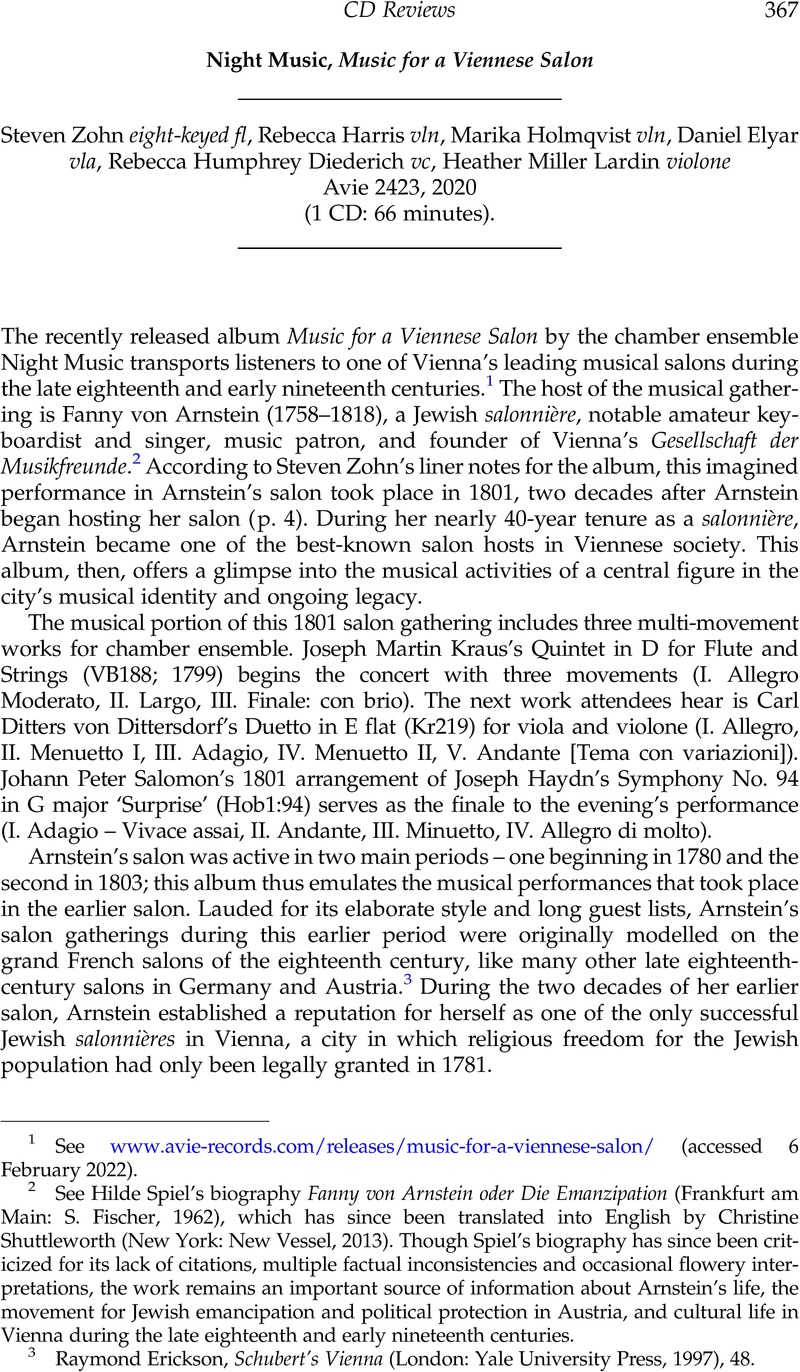No CrossRef data available.
Published online by Cambridge University Press: 04 July 2022

1 See www.avie-records.com/releases/music-for-a-viennese-salon/ (accessed 6 February 2022).
2 See Hilde Spiel's biography Fanny von Arnstein oder Die Emanzipation (Frankfurt am Main: S. Fischer, 1962), which has since been translated into English by Christine Shuttleworth (New York: New Vessel, 2013). Though Spiel's biography has since been criticized for its lack of citations, multiple factual inconsistencies and occasional flowery interpretations, the work remains an important source of information about Arnstein's life, the movement for Jewish emancipation and political protection in Austria, and cultural life in Vienna during the late eighteenth and early nineteenth centuries.
3 Erickson, Raymond, Schubert's Vienna (London: Yale University Press, 1997), 48CrossRefGoogle Scholar.
4 Details of the instruments used for this recording are included in the liner notes: Steven Zohn's eight-keyed flute is a replica of a c.1790 instrument built by August Grenser in Dresden. Rebecca Harris is playing on a Sebastian Dalinger violin made in 1794. Marika Holmqvist's violin is thought to date from around 1720 and is from the French or Flemish school. Daniel Elyar is playing on a mid-seventeenth-century German viola. Rebecca Humphrey Diederich's cello is a Johann Paul Schorn model that dates to c.1680. Heather Miller Lardin is performing on a replica of Johann Joseph Stadlmann's 1748 violone.
5 See Hanson, Alice M., Musical Life in Biedermeier Vienna (London: Cambridge University Press, 2009), 115Google Scholar. The physical attributes of Arnstein's salon have not yet been recovered or analysed by scholars, but might possibly be reconstructed from surviving family documents, personal accounts by both the residents and visitors, and government records.
6 For more on Caroline Pichler, see her autobiography, Denkwürdigkeiten aus meinem Leben: 1769–1843, edited by Emil Karl Blümml (Munich: Georg Müller: 1914 [1844]).
7 Kraus's works are catalogued in Bertil H. van Boer's Joseph Martin Kraus (1756–1792): A Systematic-Thematic Catalogue of His Musical Works and Source Study (Stuyvesant: Pendragon, 1998). For biographical information, see van Boer's The Musical Life of Joseph Martin Kraus: Letters of an Eighteenth-Century Swedish Composer (Bloomington: Indiana University Press, 2014).
8 Sarah Jane Adams, ‘Quartets and Quintets for Mixed Groups of Winds and Strings: Mozart and His Contemporaries in Vienna, c.1780–c.1800’ (PhD diss., Cornell University, 1994), 29.
9 The liner notes mention the violone's ‘tuning in thirds and fourths’, suggesting that Miller Lardin is using Viennese tuning, which is built on thirds and fourths as opposed to solely fourths (p. 4). Viennese tuning was common in Vienna during the late eighteenth and early nineteenth centuries and allowed for easier technical and melodic playing in solo literature. Tuning the instrument up a half step to e-flat also allowed for further projection, which would have been ideal for a work such as this. See Chapman, David, ‘Historical and Practical Considerations for the Tuning of Double Bass Instruments in Fourths’, The Galpin Society Journal 56 (2003): 224–33Google Scholar.
10 Hanson, Musical Life in Biedermeier Vienna, 115.
11 Erickson, Schubert's Vienna, 48.
12 Hanson, Musical Life in Biedermeier Vienna, 115.
13 Katy Hamilton and Natasha Loges have considered such questions from the perspective of Johannes Brahms's musical identity and compositions for private music-making. See their edited volume Brahms in the Home and the Concert Hall: Between Private and Public Performance (Cambridge: Cambridge University Press, 2014). Considerations of the distinctions and blurring of the public and private spheres in the twenty-first century are explored in Georgina Born's edited volume Music, Sound, and Space: Transformations of Public and Private Experience (Cambridge: Cambridge University Press, 2013).
14 See Bunzel, Anja and Loges, Natasha's Musical Salon Culture in the Long Nineteenth Century (Rochester: Boydell, 2019)Google Scholar, Bebermeier, Carola's ‘“Sundays at Salka's”: Salka Viertal's Los Angeles Salon as a Space of (Music-)Cultural Translation’, Musicologia Austriaca: Journal for Austrian Music Studies (June 2021)Google Scholar, and Cypess, Rebecca and Sinkoff, Nancy's Sara Levy's World: Gender, Judaism, and the Bach Tradition in Enlightenment Berlin (Rochester: University of Rochester Press, 2018)CrossRefGoogle Scholar.